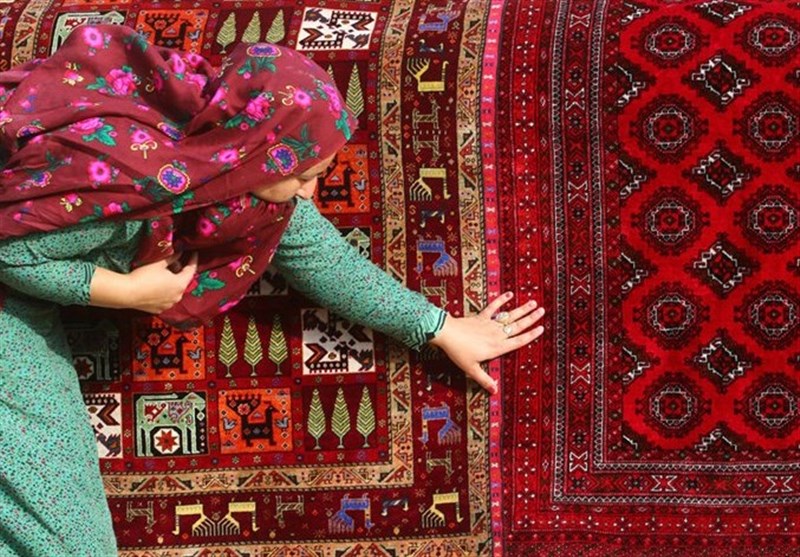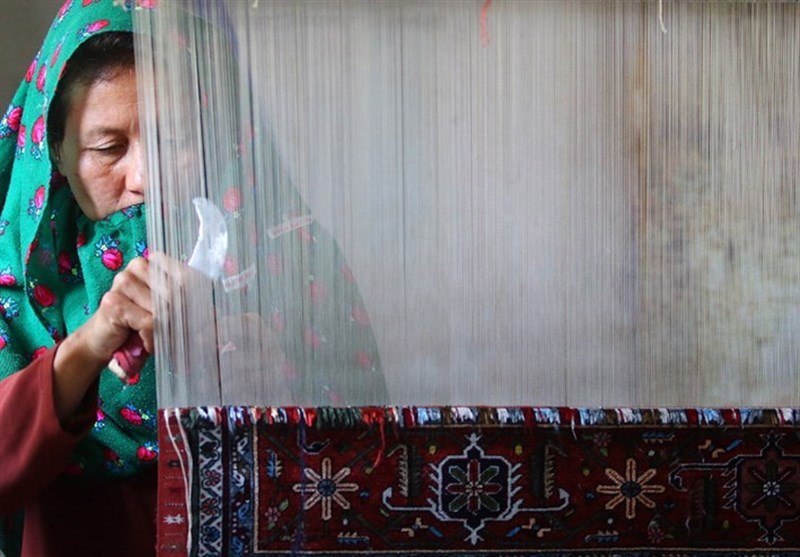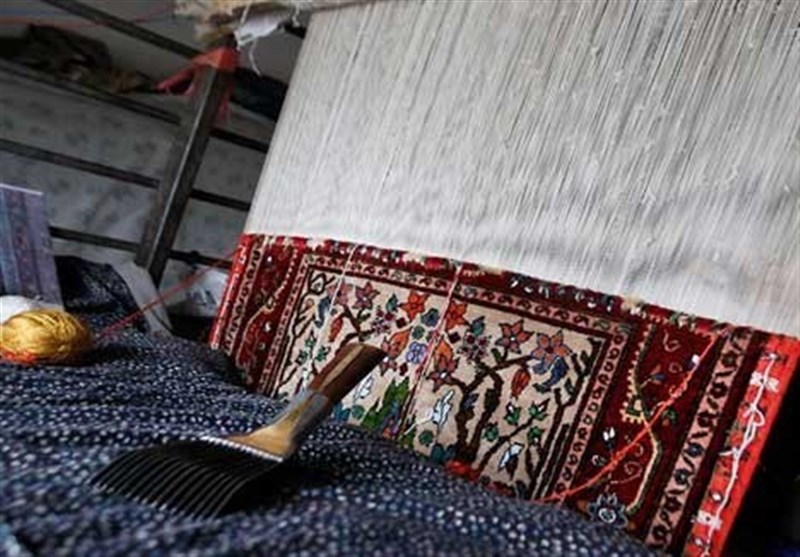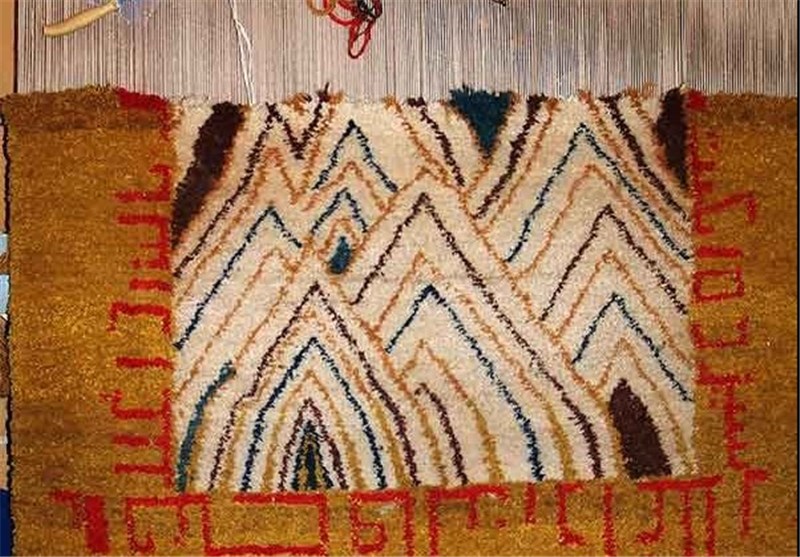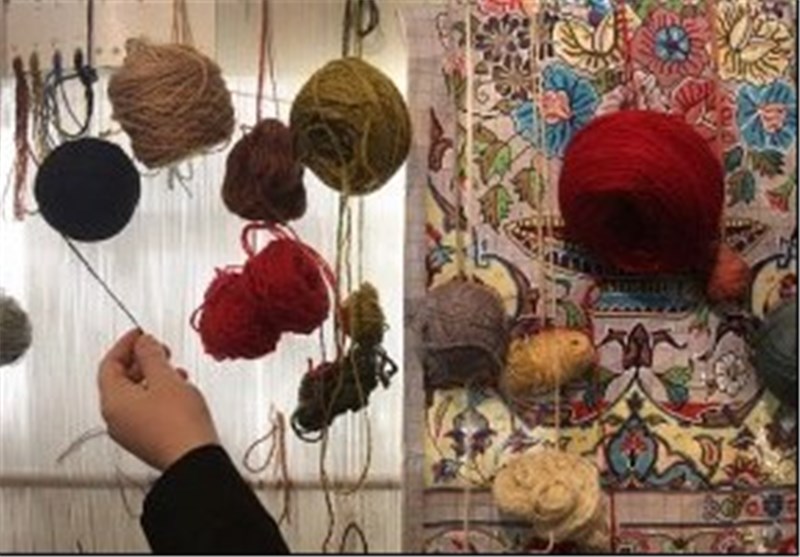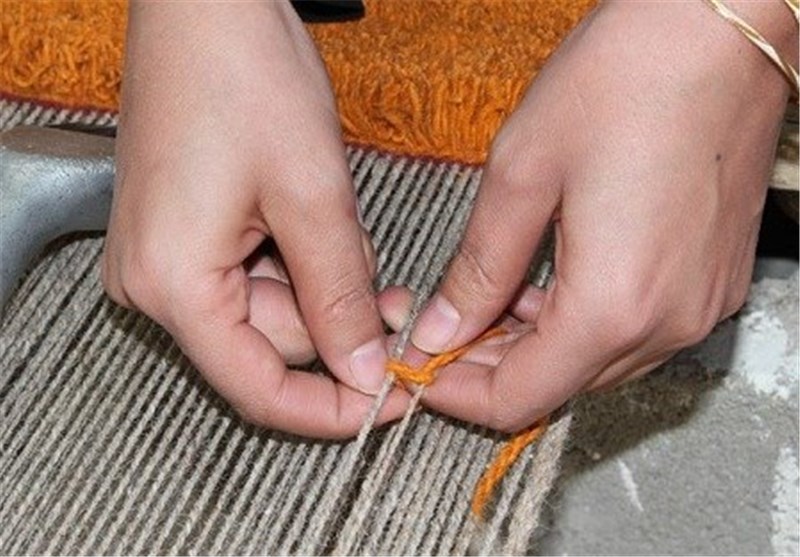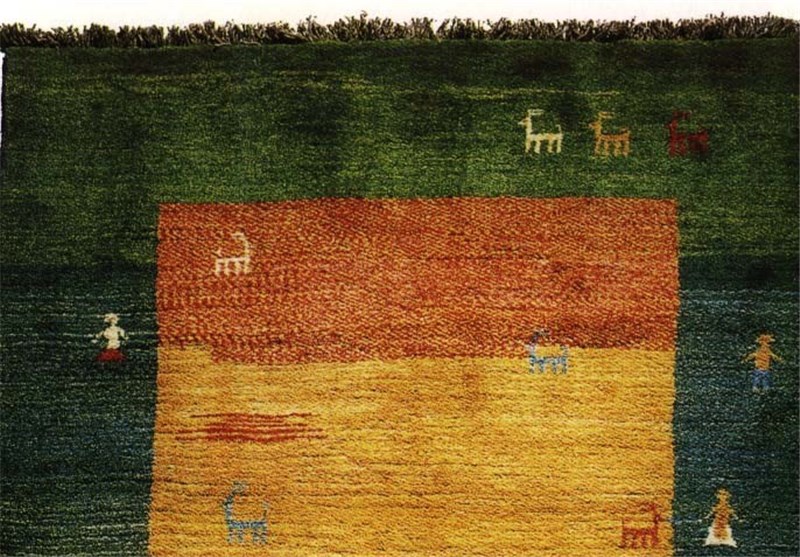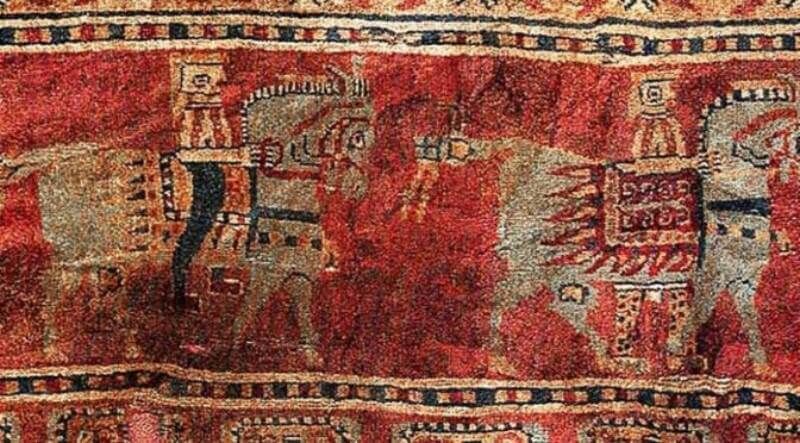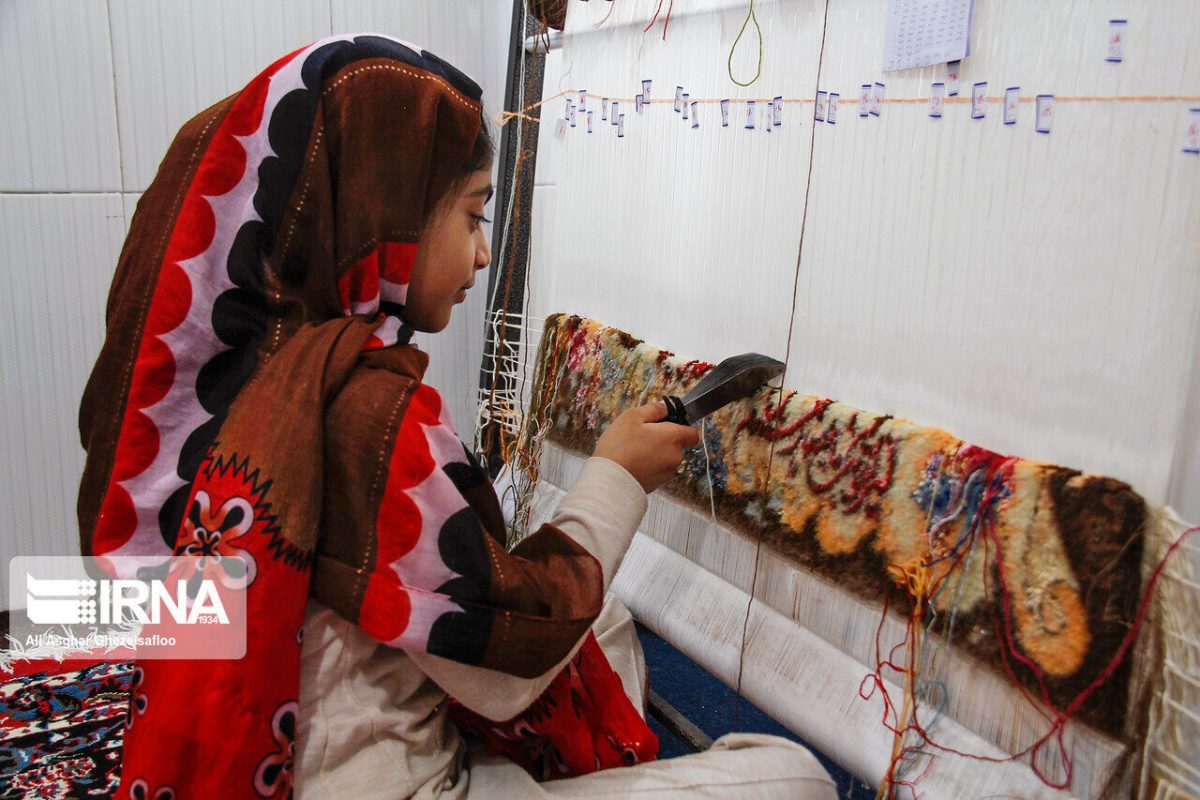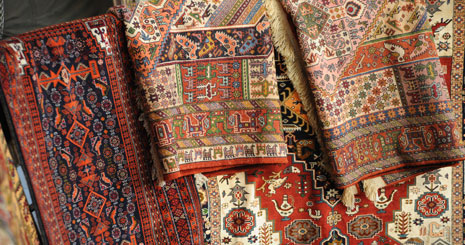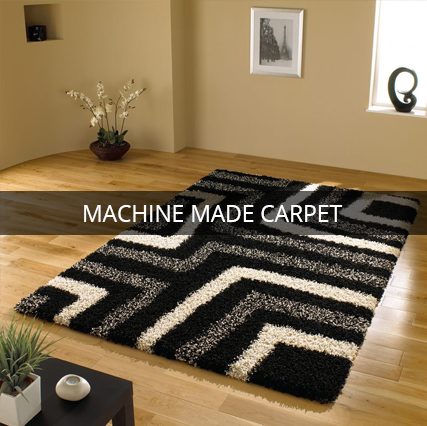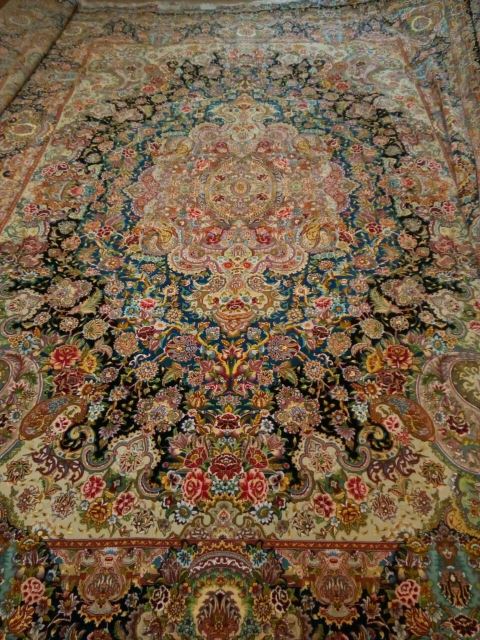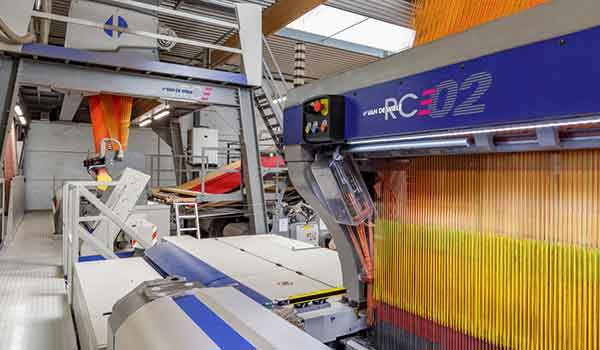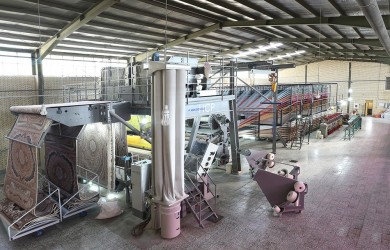Introduction
There is a multitude of unsolved problems in Persian carpet history. In general, they are typically the problems prevalent in other branches of Iranian arts and crafts, too. A carpet is not an object of infinite durability: if put to constant use, it will normally wear away within a generation or two (in 50 years, say). The few specimens remaining from the past are those that have survived either by accident, as in the case of the Pazirik carpet saved by the polar ice and of the rare fragment~that have lasted due to some favourable cellar or undeground conditions; by reason of a change in their usage – especially at times of danger – from floor coverings to objects of decor because of their uniqueness, rarity, or superior quality or design; or by being possessed by a palace or donated to a holy place such as a shrine. This is in contrast with a handicraft such as a metal candlestick which is even preserved by the very fuel it uses – the rust-preven~ing oil.
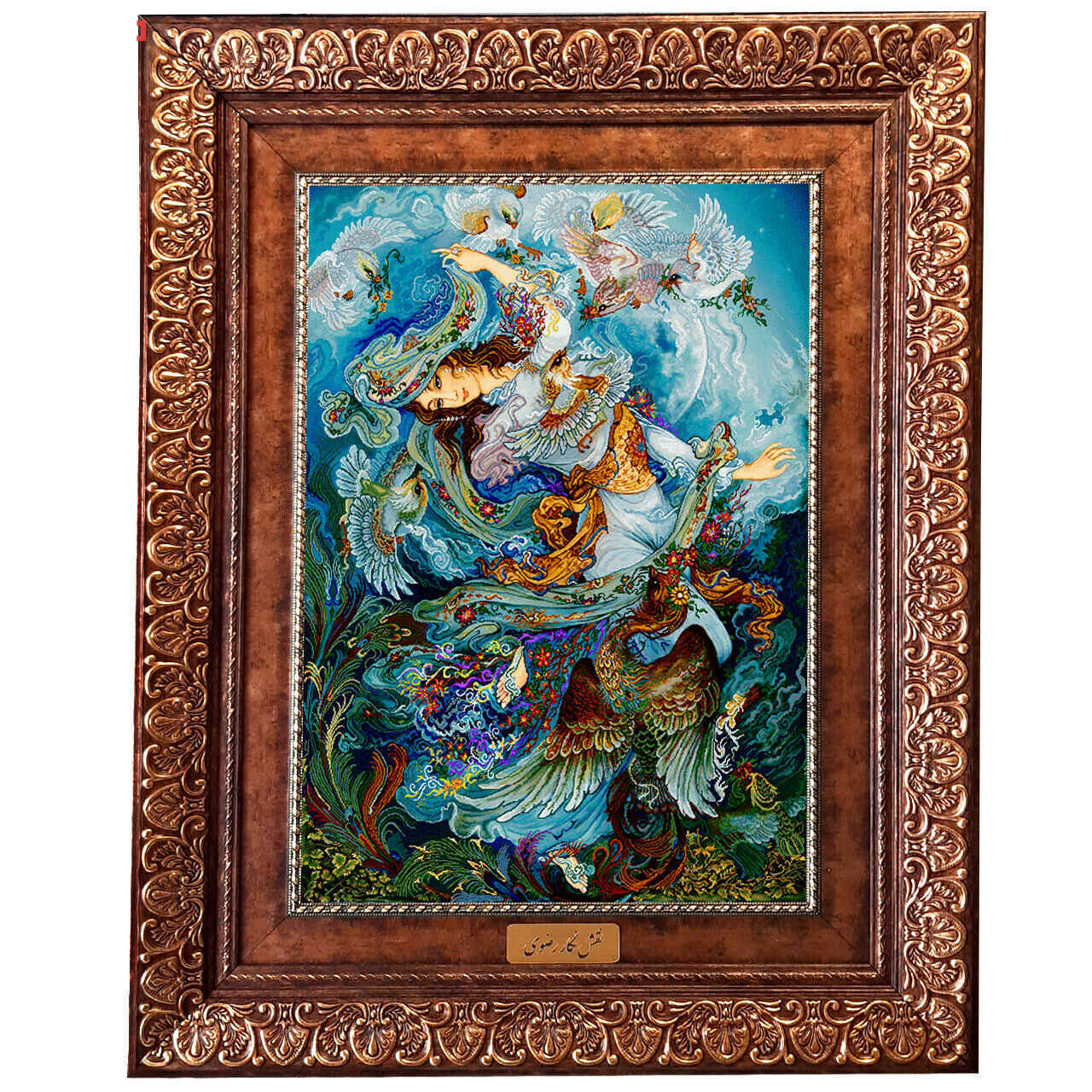
In order to follow the trail of carpet in the course of its history, every and any available evidence must be utilised. In the study of Persian carpet history, attention has been drawn to paintings that bear designs of carpets. There are paintings made by European artists which. contain illustrations of oriental carpets. Careful examination of these paintings by carpet specialists has led to interesting findings
including, for instance, the identification of a carpet design with its extant prototype. ~ The paintings of Western artists, however, are rather limited in this respect since the designs displayed on them cannot be ascribed to any specific folk or region with much certainty.
It is almost clear why Western artists have only depicted carpets with geometrical designs and ignored those with curvilinear patterns. The reasons are:
- From the 15thcenturyonwards, carpets with curvilinear designs were deemed “royal”. As such, they were not consistent with the often religious or\.llon-regal themes of the paintings of that era. How could artists possibly picture Christ or Mary on a hunting-scene or flower-garden carpet?
- Delicate patterns such aseslimi (arabesque scrolls), floral medallions, animal-attack scenes and other Persian curvilinear designs were too elaborate for those paintings and would attract too much atten”tion.
- Considering the environments that European artists intended to picture, geometrical designs provided an ambience more in tune with the artist’s desire, especially in connection with the segments intended to look exotic.
- Persian geometrical designs presented rather difficult connotations, making the painting more esoteric in interpretation – a lure for the artist. The trees, flowers, foliage, animals and hunters that filled curvilinear designs were simple, ordinary and easily understood, while art is after the novel and the unusual.
- Geometrical patterns are more abstract, stylized and artistic in character as compared with patterns that echo nature and are immediately understood.
In Iranian miniatures, on the other hand, both geometrical and curvilinear designs appear. Picturing carpets with geometrical designs on miniatures occurred as a result of a special “realism” that developed in Iran after the Mongol rule. Even those designs had to be painted with great precision in order to maintain the real dimensions of the original carpet. Yet the limited detail in a geometrical design gave the miniaturist a break from the intricacy of the work. Passing to the period of abundance of curvilinear designs, however, one notices the emergence of a-esigns -popular in Timurid and Safavid ornate miniatures – that were beyond comparison with even the Ilkhan (late Mongol) period in dimensions, intricacy or diversity of colour.
We have thus convincing reasons to justify the study of Iranian miniatures in the context of the evolution of Persian carpet design. We often come across Persian tribal or rural carpets with many an inexplicable and mysterious pattern whose connotation cannot be made clear unless we have a knowledge of its historical roots. Some such patterns even have names that do not convey any meaning to us.
Carpet design on miniature paintings is worthy of thorough scrutiny: one should find out the period to which a miniature belongs, who painted it, and what kind of environment the painter sought to depict in his work. When a painter like SolHin Mohammad Tabrizi (16th century) portrays a court environment, he would naturally present a design that is his favourite, and it is almost clear to us what his favourite designs are: the curvilinear and intricate. Indeed he was the creator of a number of actual Safavid carpet designs some of which he used in his miniatures. There is no doubt that both SoWin Mohammad an.d his master, Behzad, were directly involved, or at least influential, in carpet design. Thus, a comparison of 15th-century carpets with the designs made by the two artists would shed light on certain points, e.g., that 15th- and 16th-century miniatures reflect typical Safavid-period designs, as we Stiall.
It must be noted that from the 15th century onwards, Iranian painters tilted quite noticeably toward idealism in the demonstration of festivity scenes. Such idealistic inclination is visible in the portrayal of intricate carpet designs not only in court scenes but also -ironically – in the poetic scenes inspired by Hafez (the poet who preached and proclaimed asceticism), Nezami, Khaju, Dehlayi or even the legendary lovers Leyly and Majnun. In the miniature paintings of that period, we notice the most intricate of carpet designs of late Timurid and early Safavid eras.
Nonetheless, it should be noted that miniatures cannot cope with all the details and intricacies of Safavid curvilinear desings. The highly ornate Timurid and Safavid patterns cannot be expected to be shown in full on a carpet in a miniature that sometimes measures as small as 3 x 4 centimetres.
It is particularly noteworthy that curvilinear designs began to spread and evolve from the Timurid era onwards. Yet it should not be assumed that Persian carpet designs were entirely geometrical before then. Descriptions of ancient carpets appearing in some history books, notably the descriptions of two famous carpets Bahiirestiin and Bahiir-e Khosrow (Khosrow’s spring-tide) in Tiirikh Tabari (Tabari History)!, prove without doubt that there were Persian carpets with curvilinear designs even long before the Timurid period, though probably very seldom and specific to the rulers’ courts – as, for example, the Pazirik which is definitely not a tribal carpet. In the Timurid period, however, a wave of reform swept through all domains of art including calligraphy, carpet weaving and even mir~ture itself, making all carpet-weaving centres of Iran more inclined toward curvilinear designs.
An important issue not properly addressed yet in carpet-weaving studies is the evolution of weaving techniques in Iran. Archeological findings, some widely recognized, show that there were so-called “knotless” or, more precisely, V -knotted or V-knotted Persian carpets even before the advent of Islam. The same fashion of knotting has been seen in carpets produced in Central Asia as well as Egypt, particularly in early Islamic period. Egyptian carpets borrowed many Persian patterns, especially from the Sasanian period. Fragments of some of those Egyptian carpets, however, have been represented as bearing special resembla!lce to Seljuq or Turkish carpets in design. It is such ambiguities that carpetologic studies will certainly help to resolve.
It should be mentioned that previous to the writer, a number of researchers have made studies on miniature-borne carpet designs, the oldest attempt being by Julius Lessing about 120 years ago.2 Another scholar, Amy Briggs, has tried to elucidate ~ Timurid carpet designs on the basis of miniature paintings bearing designs of that period.3 In the present book, we will discuss the historic scope of such designs. We know of another author (S. C. Welch) who has identified a Boston Museum carpet with a design on a miniature painting.4 This is one of the instances demonstrating that miniature-borne designs are real and authentic.
Finally, an important issue that will be covered in the present book is the “Seljuq carpet” – a term that has no historic basis and has actually been branded for political and chauvinistic purposes. We will show in this book that designs categorized under that term were in fact well established long before there was any trace of Turks in Iran, especially in its western regions.
- Pope, Arthur Upham.A Survey of Persian Art.Vo\. VI, p. 2975.
- Lessing, Julius.Ancient Oriental Carpet Patterns, After Pictures and Originals of the Fifteenth andSixteenth Centuries. London: H. Sotheran, 1879.
- Briggs, Amy. “Timurid Carpets”.Ars Islamica,No. VII (1940).
- Welch, S. C. “Two Shahs, Some Miniatures and the Boston Carpet”.Boston Museum Bulletin,No. 69 (1971), p. 6-14.
The Period Under Study
In the present volume, we deal mainly with post-Mongol designs prevalent in Iran up to the end of 16th century. The reasons for choosing that period are discussed below.
Undoubtedly, the designs used following the Mongol period were more or less the same ones employed during the Mongol rule in Iran or prior to it. It is common knowledge that decorative arts did not stand a chance to develop in limes of genocide and plunder, especially in the ancient world. Patterns used in Persian carpets and tilework in those days were founded on well-defined, tradition-laden rules, and that is why there are no scenes of war, bloodshed, devastation, poverty, or captivity in those designs. Change in the realm of art was essentially a very slow process, unfolding over a long time. The change in post-Mongol Iranian painting is more distinct, with successive post-Mongol eras each complementing the previous one in parallel with economic improvements. The Ilkhans and the Turkmans paved the ground for the emergence of the Timurid dynasty, while the reconstruction and comfort achieved during the later decades of the latter in turn led to yet greater affluence in the Safavid era which brought a culmination in calligraphy, painting, architecture, tilework, carpet weaVing and other Persian arts and crafts.
A review of Iranian paintings up to the beginning of 14th century shows that geometrical designs had not changed much by then, though we do not see any outstanding presence of carpet design in the art works of early Islamic centuries except the moharramiit (parallel stripes, usually vertical) that was used in carpets and other weaves including alijeh. Ih fact, the real development of the art of painting in Iran came about in the Ilkhan period – more precisely, during the reign of Abu-Sa’id Bahador, coinciding with early 14th century – and it was in tltt; same period that the use of carpet designs on paintings began to thrive. This prompts us to start our study with 14th century. On the other hand, the 17th-century and later specimens found in most museums are so large in number that there is no need to resort to paintings or secondary evidence when talking about the evolution of carpet designs. Thus, the finishing period in the present study is the 16th century, which is one of the most important periods in Persian carpet design evolution.
IAt us begin our discussion of the period under review with a special problem in connection with a number of carpets – belonging to that period and present~y kept in certain mosques and shrines in Turkey – which, right or wrong, have been described as “Seljuq carpets”. It is unfortunate that no bold effort has been made to redress the description, while it is noteworthy that the majority of Persian carpet designs of the same period are of that type.
Therefore, it is one of our tasks in the present study to make it clear that there is no such thing as “Seljuq design”, that the designs called by that name have been common all across the Iranian territory (including Azarbijan), Caucasus, and Asia Minor, and that the resemblance of Asia Minor designs of later periods with t~ose older designs is actually due to the fact that in Asia Minor, designs were only little affected by the sweeping changes that took place in Iranian arts in the Timurid era and afterwards..
The period covered by this study saw a numbr of schools in painting that had a significant influence on Persian carpet designs, particularly in the later part of the period. The 15th century is particularly sensitive in this respect since the profound change in Persian carpet design – the replacement of the geometrical with the curvilinear – took place in that century. The transformation, as we will see later, was not introduced all of a sudden but came about gradually in well-calculated steps to avoid any frustration or clash with established traditions of carpet weaving prevalent at the time. Although the new designs have doubtlessly had significant influence on the techniques of carpet weaving, it is unfortunate that our knowledge about such influence is very limited since there is no reliable specimen or fragment from the 15th or early 16th centuries to enable a study of the structure of carpets of the time. The one or two pieces remaining most probably from the Timurid era belong to a time when curvilinear designs had fully developed and any corresponding changes necessary in weaving techniques must have taken place.
Another issue this study is concerned with is certain colour compositions during the transition period (the 15th and 16th centuries). For example, some miniature paintings display carpets with fields in green or yellow – the precursors of some colour compositions in Safavid-era carpets. Such colouring is no longer much in vogue as in present-day Iran the trend has tilted, unfortunately, toward\1he use of darker colours – a sharp contrast with the happy life styles of the nation in the past. Paintings and other specimens remaining from the Safavid period show that the turn toward the use of darker colours started during that period although even the climate and the plant life in Iran were more conducive to light and gay colours than dark ones.
The three centuries under study were also characterized by the patronage of arts by kings. Masterpieces of architecture were built under every ruling dynasty during those three centuries and sometimes one masterpiece became a symbol of the dynasty. Notable among such monuments remaining today are SoW’inyeh Dome (14th century) from Ilkhan dynasty, Kabud Mosque (15th century) from the Qara Qoyonlus, Goharshad Mosque from the Timurids, and the Shah Square conglomerate from the Safavids. All this was concurrent with the striking changes in Persian carpet weaving which were the prelude to the great masterpieces of early Safavid era.
Craftsmanship grew remarkably during the three centuries and a number of Iranian cities such as Tabriz under the (Turkman) Qara Qoyonlus, Samarqand and Herat under the Timurids, and Isfahan under the Safavids developed into important professional centres. It was in Safavid period that – perhaps for the first time in Iranian history – guilds were formed. This was the result of a rapid, b.pad and deep development in Iranian society. The trend must have had significant effects on Iranian arts and crafts – carpet draughtsmanship among them. In other words, the changes that we shall examine. in the designs of carpets on miniatures were outcomes of the wide socio-economic changes in Iran in the 14th through 17th centuries. We will follow these changes, however, only until the end of the. 16th century when carpet design developments had almost settled.
Colour And Dimensions
As most of the patterns and designs this study is based upon are reconstructions from colour photographs or plates, it is necessary to briefly touch upon their colouring in order to avoid possible confusions.
To begin with, we compared some of the pictures with the actual miniature paintings accessible in Iran, noting down the colours of the original. This led us, at the same time, to a realization of the original colours of the actual carpet that had faded with the passage of time. Based on the resuts, for instance, we came to the conclusion that the straw colour seen today in Safavid carpets was originally a rich yellow from a Euphorbia dye, paled with time. Analogous conclusions were arrived at with other colours.Jn addition, given the distinct colour-compositidh taste of Iranian carpet weavers, acclaimed worldwidly colour balance and harmony was a clue. The colouring had to be re-composed in such a way that, taking into account all the available information as well as ,the painter’s occasional shortcomings in carpet-colouring skills, it would convey the same harmony, tenderness and appeal as observed on the original miniatures without being unpleasant.
Incidentally, carpets produced in Iran from the 14th century afterwards were woven for persons not necessarily with a Persian taste who are likely to have dictated their own liking. How could the Ilkhans, Aq Qoyonlus, Qara Qoyonlus, Timuri?s and Safavids possibly cherish the same tastes as did Iranians in Isfahan, Kashan, Herat or Tabriz? As a matter of course, however, the tastes of the native people have eventually prevailed.
Although the size of the carpets on miniatures is not of much significance, in this study we have tried to verify carpet dimensions for a number of purposes. First of all, it was necessary to determine the proportion of the length and width of the carpet to the size of its patterns so that the latter would not be drawn unduly smaller or larger than their real size, thus maintaing the pattern-to-carpet size proportions – a fundamental issue in carpet design. Secondly, the size of the carpet is another aspect of the relation between the miniature and the real world; so, if the carpet dimensions determined from a miniature turn out to conform to traditional Persian carpet measures, . then it can be said with certainty that miniatures reflect real carpets.
In order to determine the dimensions of a carpet on a miniature, we first had to determine the size of the design – a difficult task, which we managed to perform using the following rules:
- Compare the width and length of the carpet with the number of people sitting on it. As the area occupied by each sitting person is computable, carpet dimensions can be estimated from the number of persons and their distances.
- Compare the carpet size with that of the space housing it, the height of the individuals, doors, windows and other structural features, trees, animals, and even the throne which itself can be sized from the figure of the king.
- Take note of the common measures of Persian carpeting such asdozar, runners, pardeh, etc., when estimating sizes by the above rules.
- Compare the carpet size with that of the objects on it, t2g., a bookholder, a candlestick, a censer, dishes, a clerk’s desk, etc., some of which have almost retained their measurements up to our times.
Schools of Persian Painting and Deccorative Arts
In the period covered by this study, the rapid development of arts on the one hand, and the coming to power of dynasties patronizing arts on the other, gave rise to a number of differQnt schools in Persian painting, the most renowned among them being the Tabriz, Bagdad, Shiraz, Herat (Timurid), Bokhara, and Isfahan (Safavid) schools. This division of schools is primarily historic, as indicated by the use of dynasty names for two of the schools. This is not to imply, however, that those schools do not differ in style. Their differences are quite distinct, but that is a subject beyond the scope of the present study.
As is to be expected, the evolution of carpet designs on miniatures seems to have been concurrent with the evolution of the art of miniature itself ~ome Persian carpet designers, e.g., Behzad and his pupil, Soltan Mohammad, were painters in the first place). It is significant, however, that Persian carpet designs on miniature paintings of Tabriz, Bagdad, Shiraz, Bokhara and early Timurid schools are similar, implying that carpet design was not much affected by the evolution of those schools. In other words, the artistic developments of the 14th and early 15th centuries in Iran did not induce profound changes in Persian carpet designs, with the consequence that the miniatures of that period show carpets with traditional designs. The latter probably had a history of 300 to 400 years, that is, their origin must be sought approximately in the 10th and 11th centuries. An off-spring of the decorative motifs remaining from Sasanian and early Islamic eras was the development of Kufic dCl;orative script particularly in the 9th and 10th centuries. Historically, therefore, thi inclusion of Kufic borders or pseudo-Kufic decorations into Sasanian and early (up to 11th-century) Islamic decorative pattern compositions must have happened during the 9th, 10th and 11th centuries since there are no known Kufic decorative writings older than those on Nishabur earthenware of the 9th century – a date that we may, therefore, regard as the beginning of the transformation of ancient Persian patterns and their merger with Kufic script.
It is important to note when and how Iranian decorative art started taking new shape in the Islamic period. In the first and second Islamic centuries, Iranian art was the continuance of that of the Sasanian era. Contrary to the common belief, Iran was not a Moslem country in the first Islamic century (Hegira), i.e., in the 7th century AD.: the conversion to Islam only started toward the end of the first century Hegira. Some Iranian territories – Tabarestan and Gilan for insta~ – had non-Moslem rulers even until the end of the first century H., the first evidence of official Islamic rule appearing in the 2nd and 3rd centl’ries H. (8th and 9th centuries AD.). Since a nation’s decorative art cannot be expected to reform overnight, based on the abundance of material even from the 2nd century H. (8th century A.D.) bearing much resemblance to Sasanian artifacts, it may be concluded that new decorative material conforming to the new religion could not have appeared any time
earlier than the 3rd or 4th centuries H. (9th and 10th centuries AD.). The first and second centuries of the Islamic rule, marked by repeated replacement of rulers, rebellions and other social and political upheavals, could not have been decisive in the development of arts.
Thus, the new decorative arts drew from two categories of material: A) those Sasanian patterns, that were not in conflict with the new religion; B) new patterns, including Kufic scirpt, decorated with ancient motifs.
In paintings of up to Timurid era, therefore, it is not unusual to: see carpet designs with pre-Islamic minor borders, Kufic main borders, and fields with traditional pattern compositions – adorned, of course, with new flavours and pattern variations. Such designs gained ground in the 10th century and became the mainstream trend thereafter. It is in this context that the extensive use of the traditional designs in works of the earlier schools (preceding the 15th century), in the Herat school of the 15th century and even in Behzad’s miniatures can be explained. It was only toward the end of Timurid era that curvilinear designs, with their eslimis (arabesque, scrolls), corners, medallions and diverse flower-and-leaf motifs became wide spread. The traditional designs in use from the 10th to the 15th centuries came in different degrees of complexity: while carpet desings in paintings of such schools as Bagdad, Tabriz, and Shiraz were simpler, those in the works of Bokhara and Herat schools were more sphisticated. This shows that with the evolution of art and the emergence of new schools, carpet design also underwent changes, though it maintained its original foundation.
The recbnstruction is slightly corrupt in that no lines should have been drawn curved. Compare it, however, with a reconstruction from Herat school (Figure 2) still containing a geometrical design though more evolved and complex than the Bagdad school.
Amy Briggs, the American researcher, tried years ago to extract the structure of carpet designs from the Timurid-era miniatures.! He produced a number of drawings (Figure 3) as skeletons of the designs popular in Timurid era. His only shortcoming is his failure to fully grasp the changes in design that occurred in Timurid era, missing a number of Timurid designs that were intermediate between geometrical and curvilinear in his skeletal patterns. We will introduce these intermediate designs and the evolution from geometrical to curvilinear forms later jJ;ee the ending chapter of this book on Presentation of Designs).
- Briggs, Amy. “Timurid Carpets”.Ars Islamica,No. VII (1940).
The General Change in Carpet Design
As stated in the preceding chapters, one cannot speak with certainty about Persian carpet designs on miniatures prior to the 14th century, for until then, the focus in miniatures was mer~ly on man, with the environment playing little role. The best examples of such miniatures are found in a copy of Samak-e A)Yar, of which a few pages are kept in a collection in the Bodleian Library.! In four miniatures of the said collection, there are carpets on which nothing is descernible other than the separation of the border from the field.
Carpet designs on miniatures took on more precision only after the reforms introduced by Ahmad Musa in painting – reforms which coused sweeping changes in arts throughout Iran. It was at this stage that carpet designs common in the 14th century appeared in miniatures, making it possible to follow their evolution through the 16th century, by which time most Persian designs known today as medallion, corner-medallion, eslimi (arabesque), Shah Abbasi (lotus) and overall had developed. From then on, most urban designs became curvilinear. Even when the Herati pattern changed to fish, it did not assume geometrical form: the curves in the figures of the fish or in flowers were retained, as were, in particular, the old and new Herati borders together with chaydan (tea-pot), Figure 5.
The oldest samples of designs on miniatures, i.e., those from the 14th century, are “semi-geometrical” in that curvatures are either absent or quite secondary. The main patterns in such designs are formed by lines and 45-, 90- and 135-degree angles, with more acute angles, say 15 or 30 degrees, used in smaller-size motifs or in borders, as in th~ sample shown in Figure 6.
M pointed out earlier, the situation changed with time. Acute angles gradually gave way to small curves; then came a combination of curvilinear and geometrical patterns; and, finally, full curvilinear designs took over. The evolution was concurrent with, and on the same model as, a parallel one in the schools of painting. For instance, Bagdad, Tabriz and Shiraz schools were more pristine than Herat (Timurid) school, and the latter than Safavid school.
The only pre-Mongol design that can be spoken about with certainty is moharramat – a very simple design formed by thin vertical or diagonal stripes. The term has no relation to the Islamic holy month of Moharram (called-Mahnnat in Pakistan). It is probably a symbolic expression of the pre-Islamic word mahr
- Robinson, B. W.A Descriptive Catalogue of the Persian Paintings in the Bodlian Library.Oxford:
- Nos. 18, 45, 72 and 76.
meaning a prayer. Through being rendered with repeat motifs such as botteh (paisley leaf), the design lost its simple semblance on carpets. However, on early post-Islamic paintings, it is seen retaining its original simple, thin form. Nevertheless, it has never been woven in such important Iranian carpet-weaving regions as Azarbijan, Hamadan or Kordestan. Thus, here we have a design which has not been common throughout Iran, particularly in its western regions – an interesting issue tor further probing, though beyond the scope of the present book.
Authenticity of Designs
Carpet designs chosen for the present book have been selected from the works of painters who are “representational”, i.e. faithful to the real shape of their subjects, when the latter happen to be objects such as the gates or walls of a palace, mosque or school, the interior of a house, household objects, musical instruments, etc., -painters, for instance, in whose works are seen patterns on royal robes or garments identifiable wit~ real cloth specimens of the period, or dishes or pots similar to those actually found in museums. This would mean that the painters chose to portray real objects, not imaginary forms; and that, logically, the carpets on their miniatures were genuine as were so many other household objects painted in their works. To explain the point further, let us briefly review Iranian painting in the Mongol period and thereafter.
The oldest book paintings in Iran date back from late Sasanian and early Islamic
I eras, mostly appearing in Sogdian books. Paintings of this period are representaional and may yield valuable knowledge if examined carefully. A researcher, for instance, has identified designs of various felt spreads with those of felt spreads still produced in Central Asia.! Following the advent of Islam and the ban on portraiture on grounds of aniconism, however, Iranian painting parted with representation. This is well reflected mainly in paintings on the margins of history and literary books of the period where miniatures were relegated a secondary or supplementary role only to visualize the narrative – more pricisely, to provide an intuitive vision of the narration. The only exception were scientific books which had to show representative images of, say, animals, as in the book titled Manafe’al-Hayawan (“uses of animals”, 14th century). As the paintings in such books were to have scientific applicability, they had to be reasonably faithful to reality. The same exception was true in the case of illustrations relating to astronomy, mathematics
- GuUisci, Zuzsanna. “The Hand of Mani, felt Rugs in Manichaean Miniatures”.Hali,No. 75
(June/July 1994), p. 81-85.
and other ,scientific subjects. This may explain why no noteworthy carpets are seen on the miniatures of the period although Persian carpet enjoyed a world-wide reputation even before the Mongols, reaching as far as China on the east anc…Egypt and Africa on the west. It is only in the decorative paintings of the post-Mongol era that we notice the reappearance of such animals as horses, dogs and birds with a deliberate display of their physical structure. And it is due to this predilection to representationality that carpet designs on miniatures find significance as reliable carriers of authentic information, especially if they have been rendered by painters whose influence on Persian-carpet design development is unquestionable.
The issue of representation in Persian miniature was posed centuries ago, and most Persian-art historians have discussed it since. Yet it appears that the subject has not yet been fully addressed, and new ideas, novel in content though marginal in scope, keep coming to the fore every now and then. It may be said that the first proper appraisal of the post-Mongol Persian painting was made by a well-known Safavid artist and calligrapher named Doost Mohammad who painted an album in 1544 for the Safavid crown-prince, Abolfath Bahram Mirza. He asserts that Ahmad Musa, the master painter who lived during the reign of Abu-Sa’id Bahador (1317-1335), broke loose with the tradition and introduced a new genre of painting which was still common in Doost Mohammad’s time. That was naturally the style which, with some modifications, continued to hold sway until the contemporary times.
Since Doost Mohammad was a highly enlightened person, his judgement on a pjnter who lived about 200 years before him bears special significance. Since the very beginning of research on Persian painting, the issue has been the subject of evaluation by innumerable specialists, while the few paintings that remained from Ahmad Musa made the evaluation a somewhat easy task. But it is interesting that in his introductory words, Doost Mohammad comments that whilst painting had made progress in China and Europe, it had been in a dormant condition in Iran until Ahmad Musa introduced his evolutionary style. The comment suggests that some information about the art of painting in China and Europe was available at the .!ime of Ahmad Musa; as we shall see later, he indeed used such information to launch his initiative.1 Ahmad Musa’s influence on the paintings after him was profound, and it would be quite appropriate to consider him as the founder of a new style in Iranian painting.2 Iranian artists’ information about the art of painting in China, especially after the Mongols, came through by the revival of the Silk Road subs-iquent to
- Schroeder, E. “Ahmad Musa and Shams-aI-Din: A Review of Fourteenth Century Painting”.Ars
Islamica, Vol. VI (1939), p. 113-142.
- Robinson, B. W. “A Survey of Persian Painting”.Art et Societe dans le Monde Iranien.Volume prepare par: C. Adle. Paris: 1982, p. 13-89.
the establishment by Mongols of strong political links among the govCAilments of north China, Central Asia and Iran to its west. As regards the information about European art, it is worthy of noting that Mogol rulers had a strong tendency toward Christianity, and that a number of them indeed had converted to it – a situation that tended to bring the Iranian court into closer contact with Western arts.
Significant among Ahmad Musa’s works were his miniatures made for such books as
Abu-Sa’id Niimeh, Kalila va Demna, Me’riij Niimeh, and Tiirikh-e Changiz (Genghis History). Not all these books have remained unscathed in the course of time. For example, the paintings of Kalila va Demna have been detached from the original book and compiled into a separate album. Basil Gray, a specialist in Persian painting, has analysed the works of Ahmad Musa in Kalila va Demna in the following words:
“… They are considerably more advanced, especially in the landscape. There is greater variety of tree, more freedom in composing, and more advanced perspective … The animals are however, very suitably, far superior in liveliness and naturalism in the fable book. In fact they were never surpassed in the Persian school in these respects. Although so well observed, they nevertheless lack the sympathy found in the fifteenth century miniatures, and consequently do not touch that lyrical height which is then the special quality of the school. But the compositions are more complex, and have greater depth. For instance the old king of the monkeys … Is not only realistically represented, but the tree grows in free space, and twists in a most naturalistic way on the bank. There are several varieties of tree in these pages … The best Il-Khanid painters had used the inward turned figure in the foreground as a repoussoir, but now… mastery of perspective … has gone far enough for the best artists to do without this kind of aid. What is still unresolved is the inconsistency of free space of the natural world in the background, now relegated to the margin, and the controlled perspective of the interiors.”l
Such questionable judgement by Basil Gray and some other specialists about Ahmad Musil’s works needs to be re-examined. Ahmad Musa was the first Iranian painter who introduced a special type of perspective into miniature, and it is ~in this very perspective that the answer to the “unresolved problem” raised by Gray should be sought and comprehended. As we know, the perspective used in traditional Persian miniature is parallel perspective with botom-to-top recession; that is, the parts of the scene closest to the eye are represented at the bottom of t5 plane and the farthest at the top. Another type of perspective, prevailing now, is called “linear” or “centred”, and is not applicable in miniature. In this type, lines that are actually
- Gray, Basil.Persian Painting,Editions d’Albert Skira, 1961. p. 36-37. With regard to the last part of
the quotation, see Figures 7 and 8.
parallel are drawn converging at a point that represents the farthest visible location, and the farther an object is from the viewer the smaller it appears – just as in realty.
In view of the foregoing, one ought to distinguish between Abmad Musa and other painters, particularly those before him, to see how committed he was to representation and what his perspective was like. Only then will it be possible to decide how realistic a dog, a tree, a fiddle, a tent, and a carpet, are in his works and in the works of painters after him. Abmad Musa introduced into miniature a special perspective which is practically a deliberated combination of the two types mentioned above: on the whole, it is “miniatural,” i.e., a parallel perspective with bottom-to-top recession, while in details it is “centred”, sometimes even using shades to show relief. It seems that Abmad Musa signalled the painters after himself to pay more attention, at least in details, to nature and to the physical anatomy of their subjects – an unprecedented practice before. While the innovation caused a great change in the art of miniature, the originality remained intact and its fundamental conventions unaltered. In fact, it became more lively, expressive and evidential; shed its solely supplementary or decorative function and began to express a visual world far more vivid than a common historical, religious or fictional text. Abmad Musa freed the miniature from being a mere appendage to a book and gave it an independent identity.
Abmad Musa has no doubt made further innovations which do not fall within the scope of the present book. The painters after him, mostly influenced by him, applied his achievements sometimes with even bolder elements, leading to the emergence of the important Shiraz, Timurid, and Safavid schools.
Let us now go back to the issue of carpet designs on miniatures. It has been reported that things like palaces and carpets also appear in Abmad Musa’s works. Unfortunately, only one or two such specimens have been printed. Painters -after Abmad Musa, under his influence, equally observed representation in their paintings. We will, therefore, only discuss a couple of the master’s works, remembering that he was a painter of early 14th century, and his paintings show carpet designs commonly in use at the beginning of that century. The two niiniatures presented here are from the book Kalila va Demna (Figures 7 and 8). Each shows only the border design of a carpet. The designs are known as Kufic. However, due to the wide publicity for Seljuq carpets in the West, such designs have regrettably come to be considered as in Seljuq style of Asia Minor, whereas they are frequently seen in carpets on Persian miniatures of the 14th and 15th centuries even of Herat and Bokhara schools. In either painting, a bed obscures the field. At one corner, there is a very small triangle which doesnot seem to represent a corner piece, but is probably a part of a repetition design similar to what is seen in other specimens. The natural look of the trees in both paintings is particularly noteworthy.
Borders similar to those described above can also be seen in other paintings of the same period, including one on a miniature (Figure 9) which depicts the scene of Alexander’s death, in a copy of Demotte Shahnameh now in Freer Gallery of Art, Washington.! In front of the scene there is a carpet with a Kufic border and a chequer field which has in each square a version of the pattern known as pie (variously translated as “knot” or “knot of destiny”, and parts of at as “knot derivative” or sometImes just a “bend”; see Figure 10). As we shall see, a large number of borders In Persian carpets were designed with these patterns before the 15th century. Such borders can be seen in all Persian carpet designs up to the Timurid period. Other border patterns occured very seldom and we will take a look at them later.
Kufic borders usually belonged to the designs known today as “repetition”. Their widespread use in miniatures is an indication that they were urban designs much favoured in the royal courts, mansions and courtiers’ palaces pictured in those miniatures. Kufic borders of the same type were being used in carpets produced in Azarbaijan, particularly in Ardebil, as recently as 50 years ago (1940’s) when they became obsolete with the spread of new urban designs such as Heris and fish (Heriiti) to the entire Ardebil region, especially to the rural areas that used to weave traditional designs such as triple-medallion, penta-medallion, etc. This indicates that the last bastion of the urban, Kufic-border carpets within present-day Iran was Ardebil city, while their production in the cities of Azarbijan Republic continues to the present time.
The scenes of rural and ordinary life depicted in some miniatures point to the simplicity of carpets used by the population at large. It is very likely that some of these were other floor coverings (e.g., felts), like the one seen in the painting captioned “Bahram V in a villager’s cottage” (Figure 11), in Vazir Qavam aI-Din Hasan’s Shiihniimeh, Shiraz, 1341, presently kept at WaIters Art Gallery in Baltimore.2
Regions farther from the Timurid and Safavid art centres were influenced later.
- Gray, Basil.ibid.,Skira, 1961, p. 32. Also See Gantzhorn, Volkmar. The Christian Oriental Carpet.
KOln: Benedikt Taschen, 1991, p. 158.
- Gray, Basil.ibid,p. 58. In the mosques on miniatures, zilus and felts are almost always pictured. See, for instance, two miniatures by Behzad in: Robinson, B. W. “A SUlVey of Persian Painting,” Art et Societe dans le Monde Iranien. Paris: 1982, p. 44. see Also: Martin, F. R. The Miniature Painting and, Painter, India, Turkey from The 8th to 18th Century. London: Bernard Quariteh, 1912. Vol. 2, pI. 70; and Pope, Arthur Upham. A Survey of Persian Art, Val. X, p. 887.
An interesting case is a miniature – perhaps from Bokhara (1521 or 1522) titled “Badi’ al-Zaman’s Fiest”, in the Turkish copy of Nava’i’s Khamseh (Figure 12).1 The feast is on and around a relatively large carpet with a curvilinear design and the familiar Kufic border. The field is clearly a medallioned overall, showing, however, that the painters of the region were tied to the past tradition and unable to break away from everything in older designs.
Recapitulating the foregoing, there are three types of designs to be found in
miniature paintings:
- very simple designs probably of rural or tribal origin;
- rural and tribal geometrical designs but closer to urban influences;
- urban designs belonging to courts and mansions of the nobility.
The third of this grouping enjoys a wider variety, exacting a detailed discussion.
In fact, it was this group of designs that prompted the author to write the present volume. As was pointed out in the Introduction, there has been only one miniature-based design so far that has been identified with an extant carpet in an American museum.
The Fiction of Seljuq Carpet
In the mosques and shrines of Asia Minor, carpets have been found that date to the 14th century. Since part of this period coincided with the Seljuq kingdom of Rum, the carpets of the period have come to be generally named after the dynasty. However, the strong bias of studies in today’s Turkey on the one hand and certain preoccupations on the part of We.stern researchers on the other have resulted in ascribing to Turkish origin the Seljuq-period carpets whose weavers were not Turks nor had anything to do with Turks other than being under a Seljuq government. This has led to the concoction of a whole “important” chapter for Turkish carpet history. Fortunately, miniatures and other evidence remaining from the period allow a re-examination of those carpets.
A characteristic technical feature of Seljuq carpets is the symmetric knot, referred to as the Turkish knot in Eastern tradition.2 Today, it has been established that this knot has nothing to do with Turks since the Turks themselves use the Persian knot in their own land of origin (Central Asia), Turkish knot beiqg used only by the Turks who have either migrated to the western regions of Iran or
- Sredneaziatskie Miniature XVI-XVIIIBB.Vstupitelnaya Stat’ya N.V. D’yakonovoi. Moskva: Nauk, 1964, p. 22, No. 8.
- Rece~~ly, some Seljnq specimens with the Persian (asymmetric orSenneh) knot have been reported.
See: Olcer, Nazan, et al. Turkish Carpets from the 13th – 18th Centuries. Istanbul: Ahmet Ertug, 1996.
learned carpet weaving from the Iranians living there. The Turkish knot has been and is still used all across the northwestern parts of Iran up to Arran (North Caucasus), Asia Minor, west of Iran (by the Kurds and Lors), and even by the Kurds of Iraq who have seldom woven carpets. Any discussion of the technical aspects of carpet weaving would be worthless without taking into account the local traditions and geographical and ethnic ties. The mere attribute “Turkish” does not necessarily prove any origination with the Turks. If the Turkish knot were of Turkish origin, it should be in use to the east and north of Iran, which it is not.
It is known that theSeljuqs of Iran acquired an interest in Persian language – so much so that the last kings of the dynasty even wrote Persian poetry. The Seljuqs of Rum went even farther and not only made Persian the official court language, but assigned Iranians to their ministerial posts and adopted a bureaucracy totally \Iranian. While Iranian Seljuqs liked to use Arabic titles before their names, the Seljuqs of Rum preferred to adopt the names of Iranian mythological or pre-Islamic kings.
Influenced by Iranian culture, the Seljuqs of Rum patronized poets, writers and architects. Under their rule, the spread of Irano-Islamic culture picked up in pace and set the stage for the rise of the Othoman rule. The Seljuqs of Rum built their palaces on the Iranian model and decorated their walls with scenes from the legends in Shahnameh, which explains why their kings adopted heroes’ names from the book.
Until the 14th century when a new wave of Turks arrived in Asia Minor, Persian was the commonest language there and was understood and liked even by ordinary people; a multitude of books were written in Persian; and many poets, even some Seljuq kings, wrote their poetry in Persian, to the extent that Persian could be considered the cultural language of the Seljuqs of Rum.
The question now arises as to how a person used to decorating the walls of his mansion with scenes of Shahnameh, calling his sons by ancient Iranian names Keyqobad or Keykhosrow, having the palace correspondence written in Persian- by ministers from Tabriz, Toos, Kashan, Deylaman, Isfahan,…, writing poetry in Persian and patronizing Iranian culture could take to using Turkish carpets. If Seljuqs were the first Turks to dominate Asia Minor, how did they take carpet weaving there?
How could it be that the original Seljuqs who ruled Iran did not have qj”Seljuq” carpet and there is no mention of a Seljuq carpet in any his~orical document, yet a branch of the Seljuqs far from their original habitat had a “Setjuq” carpet industry of their own?
The truth is that those carpets are neither Seljuq nor of Turkish origin. At that time, Persian carpets were made almost everywhere in Iran, including Caucasia and Arran, with their traditional, patterns appearing mostly on carpets of the regions at the outer rim of Iran such as Turkman, Systan, Caucasia, Arran and, of course, on the so-called Seljuq carpets. Carpet designs similar to those of Asia Minor are also seen in miniatures, in weaves of both Iran’s Azarbaijan and the Republic of Azarbaijan, and in ancient textiles woven in some parts of Iran such as Dargazin.l
One should note that most of the earlier inhabitants of Asia Minor under the Seljuqs of Rum were not Turks, and that Armenians, Greeks and other nationalities were engaged in carpet weaving there. Since they all used the so-called Turkish knot, clearly they must have learned it from the Iranian folks east of Asia Minor. The oldest and the most prominent of Seljuq carpets are the ones allegedly woven in the 13th century for AHi’eddin Mosque in Konya (1219) on the order of AHi’eddin Keyqobad. Notwithstanding the close similarity of their designs with those of other carpets so called, there are serious doubts about the theory that they were woven in the 13th century, the arguments and evidence against it being substantia1.2) TeChnical and cultural aspects discussed, let us now look at design features in
Seljuq carpets. Although no carpet belonging to the Seljuq period has been found in Iran to date, the patterns attributed to Seljuq can be traced in other Iranian objets d’art. To start with, note that in Iran or elsewhere, division of crafts would diminish if we travelled back in time. Around a hundred years ago, for instance, Iranian carpet designers also made tile designs. Such cross-specialization was wider in those crafts that had common origins or aspects. For example, Behzad and his pupil Soltan Mohammad were both involved in carpet design as well as painting. There have also been common designs for carpets and textiles even before the Mongol era, the most renowned being the moharramiit (parrallel stripes, usually vertical) often seen on textiles and garments in pre-Mongol paintings. Thus, if the patterns used on cloths, buildings or other objects are found. also on Seljuq carpets, then it would be only natural to infer that the common source must be among the people who first made them. Fortunately, there are enough archaelogical findings to allow the tracing of those patterns and designs at least from the Buyids (10th century) onwards. At that time, there were no Turkish elements yet to influence the patterns used in Iranian carpets, cloths or other articles. As we shall see later, those very patterns had wide application in carpets up to the Timurid era which marks the beginning of curvilinear designs. Patterns composing the Islamic-period designs are essentially Sasanian in origin and are seen abundantly in the architecture of the Islamic period (Figure 13). Scores of such patterns are also seen in Iranian pre-seljuq buildings.
The structural components in the design of the supposedly Seljuq carpets comprise the following:
- Pope, Arthur Upham.A Survey of Persian Art,Vo!. VI, p. 2355.
- See, for example: Parham, Cyrus,Tribal and Village Rugs from Fars,Vo!. 11, Tehran: Amir Kabir,
1992, p. 350-2, on similarities of some Asia Minor carpets with Persian tribal and rural ones.
- borders which are usually described as Kufic since the forms used in them are often
similar to Kufic letters;
- a field composed of the same forms, geometrical patterns, or medallions similar to those in geometrical partitioned or multi-cartouche designs often found in Persian rural village carpets (see Figure 80);
- patterns composed of motifs such asmorghak (bird’s head p) or qucak (horns~) in a variety of combinations.
Let us now consider samples of Se1juq-carpet patterns that also appear on a wide range of articles from architectural monuments to carpets and clothes. It should be noted that the broadness of pre-Islamic arts in Iran offered suitable ground for the development of all post-Islamic patterns. Unfortunately, however, Sasanian seals and
insignia are the only objects that bear decorations with Pahlavi script. Figures 14-16 show~bles and well-known seals carrying letters in decorative arrangements. On the ot3br hand, a large number of pre- Islamic motifs are the simpler precursors of
post-Islamic patterns used in various items including carpet. Some of them, such as the border termed khompii (swastika, Figures 17 and 18), were presumably found useful in decorating Kufic script and were later utilized in Kufic decorations on buildings.
It has been established today that a large portion of early Islamic decorative patterns employed in stucco and brick-work have been derived from pre-Islamic, especially Sasanian, patterns. Figure 19 shows an Islamic seal immitating the Sasanian samples. Other specimens remaining from the first four centuries of Islamic craft are too few to be conclusive. The samples in Figures 20-25 are seen in both Sasanian and Islamic periods. In demonstrating such connections between the two as well as between their patterns and those in Seljuq carpets, we try to keep to their chronological order to show that the patterns abounded even before the migration of Turks to Asia Minor or before the Seljuq rule.
The oldest sample of decorative Kufic script with reliable dating is from the 9th century, whence there are works in which the script has been used for decoration only. Although the inscriptions were supposed to be omens for blessing, esteem, health, etc., they need not have been either on objects such as erthenware or in decorative form. Yet they are. This indicates how the spread – evert the dominance- of decorative arts caused Kufic script to reform, particularly in Khorasan, under the very rule of the Abbassid Califate. From specimens found in various regions of Khorasan, a few are shown in Figure 26.
Some Sasanian patterns played an important part in the development of Kufic decorative forms, the most common being the pentafoil, quatrefoil and trefoil which decorate the upper endings of Kufic letters (Figure 27).
The oldest Kufic inscriptions on brick-work and stucco date from after the 10th century. An outstanding example is a piece from Bistun (Figure 28) belonging to the Buyid period.
Many of the border designs used on Seljuq carpets and in miniatures were common in the 10th century (see Figures 54 and 55). Other specimens of that century are not few; among them: the inscriptions of Uijim tower and lame’ Mosque of Na’in (Figures 29 and 30).
No doubt such specimens, wherever they happen to be found in the Islamic world, have borrowed from Iranian art for the obvious reason that using scripture for decoration was common in Iran first. Moreover, the most ornate scripts, including Kufic have been developed in Iran and can be seen in Iranian monuments. From the 10th century, Kufic-script decoration evolves in leaps, as seen in the inscription of Masjed-e Mesriyan (Egyptians’ mosque, Figure 31) and Pir-e Alamdar in Damghall\ (Figure 32). The exact date the former was built is unknown though late 10th orjarly 11th century is the estimate. The latter inscription dates from 1027 and is among the most sophisticated and ornate Kufic specimens in Iran. The presence of various versions of pie (knot of destiny), believed to have been borrowed from Chinese art, is remarkable though apparently no relations with China existed at the time.
Decorative Kufic script evolved and advanced remarkably in Iran, leaving a striking impact on all Iranian decorative art and receding in status only after the advent of the Nasta’liq calligraphy. Figures 33-53 show other specimens from the 10th century onwards.
The Kufic borders of Seljuq carpets, however, are not scripture. Thus the question arises as to how its forms developed from Kufic script. The first etudes to -develop non-script Kufic decorative forms had started in Iran long before Seljuq carpets were woven. Figures 54 and 55 show 10th-century and later border designs compatible with Kufic. Some etudes for non-script Kufic borders, which are plenty in Iranian architecture, are shown in Figure 56. To conclude, let us note two essential points:
- Kufic borders and the patterns within the borders seen in Seljuq carpets have been and are still common in places distant from the central parts of Iran – in today’s Republic of Azarbaijan, for example. Figure 58 shows some sample~ collected by Azari scholar Latif Karimov. A miniature drawn in 1468 in Shamakha, a town near Shirvan in Caucasus, shows three carpets with such border designs (Figure 57).
- Decorative Kufic was so attractive that it spread as far as China to the east, and as far as the Eastern Europe to the west where it was also used in church decorations (Figures 59 and 60). Europe’s Kufic inscriptions belong to the 10th century when not a single Seljuqian had been born, let alone managed to travel from Central Asia to Iran, mastered the Kufic border- and taken it to Europe. In the Spanish ikat of Figure 61, too, although woven in the 13th century, Iranian patterns and an ornate Kufic border are seen belonging to long before the Seljuqs.l
The question may now be raised as to what is meant by the “Turkish carpet” then, and whether it has or has not a history or roots of its own. The brief answer is clear: Every nation has terms for whatever it has. The majority of carpet-weaving terms used among the Turk peoples from the east of Iran (e.g, Uzbekistan) to the west (Turkey), are Persian or borrowed from other Iranian languages and dialects. Moreover, most patterns, designs and weaving techniques of the Turks are from the neighbouring peoples.2 Unfortunately, incorrect interpretations of history are sometimes put forward even by experts. For example, let us quote a passage from Ernst Grube, an expert in Islamic weaves, which was stated in 1964 and today we know is completely wrong:
11 … The woolen knotted rug of the Muslim world is not a court product, and its origin goes back not to the high cultures of the Ancient Orient, but to that of the Turkish nomads of Central Asia. It seems that the rug was actually introduced into Western Asia by the Turks that penetrated into Afghanistan and Iran as early as the 9th century, and that eventually ruled all of the Eastern part of tl!e Muslim world including Iraq and Anatolia…”3
The discovery of fragments of Sasanian carpets in Qumes (ancient Damghan in’ Iran) discarded such claims – a reminder to researchers to shun speculation particularly about a subject that whose records is not well documented or clear enough to him.
Figure 62 shows a fragment of a Timurid carpet in Benaki museum. Although this piece has been ascribed by carpet specialists to Azarbaijan and Asia Minor, the latter’s carpet weaving is actually an offshoot of the weaving tradition in north-west of Iran with its main characteristic being the symmetrical (“Turkish”) knots. As seen, the patterns are essentially geometrical and of a type still in use in the carpets of Azarbaijan (Reris, for instance) and Caucasus. In Turkish museums or monuments and elsewhere, there are other fragments which must be examined one day.
An important measure unheeded so far is the microscopic examination of carpets ascribed to Asia Minor to determine such technical features as the type of wool andsheep, colours, knots, knot orientation, weft-running methods, etc. These data
- Hali,No. 63 (June 1992), p. 98. lrano-Islamic art moved into Spain through North Africa from the
8th century.
- Hassouri, AlL “Yajegan-e Torky-e Farsh” (Turkish Carpet Terminology).Teppich Welt,No. 8
(September 1994). p.5.
- McMullan, Joseph V.Islamic Carpets.New York: Near Eastern Art Research Center, 1965. p. 10.
would be valuable in deciding the place of production. Without them, no judgementmay be conclusive and only the geography of the weaving traditions will continue to be the main yardstick for deciding the original location of a carpet. This method is too general and can only tell whether a carpet is from the east or west of Iran at best.
European Paintings and Carpet Designs
This chapter is aimed at highlighting the resemblances between what has been shown in European paintings and carpet designs found in Iranian miniatures, touching briefly upon a few specimens pertaining to the subject. So far, the carpets reflected in the works of European painters have been judged to be definitely of Anatolian origin. The judgement has been as successful as Gantzhorn’s attempt to ascribe them to Armenia.1 By that approach, anyone else can run a comparison between them and the carpet designs in 14th-century miniatures and conclude that the- rc:rmer are entirely Iranian! There is no doubt that due to the proximity of Europe with Anatolia, some of those carpets may have been from that territory, as they could have been from Caucasus or Arran. No systematic study of the features other than the weave and the patterns (as discussed earlier in this book) has been carried out on those carpets to resolve the question of their origin.
It is important to note that the two features mentioned are widely noticeable in carpets produced in the west (especially in the north-west) of Iran. At the International Conference on Oriental Carpets (ICOC) held in Hamburg in 1993, a 15th-century carpet was on display with Turkish knots and a design of the type discussed above, but while experts thought that it belonged to the north-west of Iran – Azarbaijan, to be exact – the carpet had been found in Tibet.2 The point is that such works of art belonged to a single cultural domain which, pursuant to the colonial moves for the division of the western part of Asia, is now known under the names of several countries. Iran has been the core of that cultural domain.
In a famous painting by Hans Holbein (Figure 63), there is a carpet which has prompted a lot Of debate. It has a Kufic border surrounding a partitioned (multi-medallion) field. Figure 64 shows a 16th-century painting by Lorenzo Lotto with the same type of border. Figure 65 is a painting by Evaristo Bascnis with a kind of inscription border. Both latter carpets have a field design that has been common across the north-west of Iran from Azarbaijan to Asia Minor as evidenced by its many extant specimens. Figure 66 shows a carpet with Turkish knot found in
- Gantzhorn, Volkmar.The Christian Oriental Carpet.k5ln: Benedikt Taschen, 1991.
- Orient Stars, A Carpet Collection:E. Heinrich LondonlHannover: Krich-Heim and Hali Publications,1993.
northern Egypt. With his Armenian and Christians bias, Gantzhorn holds that the carpet is a product of the Armenians of north Egypt.
Figure 67 shows a carpet painted by the 15th-century artist Domenico Ghirlandajo, with a dual border (a Kufic and an S-chain) embracing a double-medallion field. This is a design that may have been woven anywhere in Iran.
Even some pre-14th century Persian carpets with particularly simple designs have. shown up in Western paintings. The fact that such paintings usually belonged to the religious places of Europe is an indication that simple-patterned carpets were more favoured by the church in the 13th and 14th centuries (Figures 68-70).
Presentation of The Designs
In this chapter, we will introduce Some designs of carpets on miniatures, trying to go from the simplest to the most complex.
In the chapter dealing with schools of paintings in Iran, it was pointed out that schools differed in their design, This is not a general rule, however. It may happen that a very/old design shows up on a recent painting. Obviously, when the subject happens to be a royal palace, the designs are more advanced, whereas in a modest environment even a rug fragment may be picturedl, regardless whether the painter is of the Timurid or Safavid schools.
The designs in this chapter, therefore, have been arranged in the order of their historic changes from the simple to the complex and from the geometrical to the curvilinear. It will be noted that in their simplest form, designs have a simple structure with little or no interconnections between separate elements. Later, both the elements and the structure become more complex with greatly increased interconnections. Such was the case with the Timurid (15th century) designs which were not too distant from the curvilinear. In fact, some curvilinear elements do appear in Timurid designs, gradually gaining dominance to form the curvilinear designs. For each design presented here, a short description is given together with the miniature it has been reconstructed from.
Some rare and uncommon designs have been excluded from our reconstructions. These are designs that contain figural (animal) motifs. Only one such design has been seen on a miniature (Figure 77). The rare appearance of such carpet designson miniatures is probably due to the restrictions of Sunnites and urbanites about visual
- Carpets were sometimes fragmented to pieces to be given away as alms or charity. See: Hassouri, AIL “Two Halves of the Same Carpet.”Papers, Presentations; 7th International Conference on Oriental Carpets.Hamburg: The National Organizing Committee of ICOC, 1996. p. 137-141. Also: Martin, F. R. The Miniature Painting and Painters of Persian, India, Turkey from The 8th to The 18th Century. London: Bernard Quariteh, 1912. Vol. 2. pI. 71.
arts. Not a single animal figure is to be found on Turkman carpets of up to 50 years ago. Persian pictorial carpets used to be produced in places away from the main centers – usually in villages. The modern outlook is of-course different.
As our discussion is mainly focused on pattern and design evolution from the simple to the complex, we do not differentiate between the designs on miniatures and those on European paintings. On the other hand, miniature specimens of certain Iranian designs such as the triple-medallion and the double-medallion are too few. One example is the design in Figure 76 which, incidentally, carries the sketch of an animal. In the Demotte copy of Shiihniimeh, there is a miniature showing Zahhak the Miirdush (snake-shouldered) sitting on the throne with a carpet spread under his feet. This copy was compiled in Bagdad over the years 1330-1336. As seen in Figure 77, the design is double-medallion with an S-chain border. Inside one medallion there is a dragon-like figure. The other borders of the carpet are also very attractive, with two of the outer ones (the first and second) now forgotten.
Another ~ery old specimen of multi-medallion designs is a miniature about A1exander~eath in the same copy of Shiihniimeh (Figure 9). A carpet is spread in the forefront with a field design comprising elements shown in Figure 10. This is one of the most expressive paintings of its period. The carpet, the bed, the coffin, the curtains, the lights, the chandeliers, the pendants, the apparel, and even the acts of mourning (such as shedding head scarfs, pulling hairs off, garment ripping, breast beating) all are very real. The design, therefore, must be considered as one very common early in the 14th century.
Figures 78-81 are Briggs’s recons~ructions of designs from Timurid miniatures. But his work is not without shortcomings, as was noted, due to his lack of attention to the evolution of carpet design in Timurid era (Figure 3).
Briggs, Amy. “Timurid Carpets”. Ars Islamica. Vo!. VII (1940).
Gantzhorn, Volkmar. The Christian Oriental Carpet, Benedikt Taschen, 1991.
‘Gray, B. Persian Painting. Skira 1961. Gulasci, Zuzsanna. “The Hand of Mani, Felt Rugs in Manichaean Miniatures”. Hali 75 (June/July 1994).
Lessing, Julius. Altorientalische Teppich Muster nach Bildern und Originalen des XVXV I J ahr-hunderts.
Martin, F. R. The Miniature Painting and Painters of Persia. India. Turkey from The 8th to The 18th Century, London: Bernard Quariteh, 1912. Vo!. 11.
Martin, F. R. The Mmiature and Painters of Persia. India and Turkey from The 8th to
The 18th century, Vo!. I, London: Bernard Quariteh, 1912.
Mc Mullan, Joseph V. Islamic Carpets. New York: Near Easter Art Researc Center,1965.
Pope, Arthur Up ham. A Survey of Persian Art. Vo!. VI.
Pope, Arthur Upham. A Survey of Persian Art. Vo!. X.
Robinson, B. W. “A Survey of Persian Painting”. Art et Societe dans le Monde Iranien.
Paris: 1989.
Robinson, B. W. A Descriptive Catalogue of the Persian Paintings in the Bodleian Library. Oxford: 1958. Nos 18,45, 72 and 76.
Schroeder, E. “Ahmad MuSII and Shams-ai-Din: A Review of Fourteenth Contury
Painting”. Ars Islamica Vol. VI (1939)
Sredneaziatskie Miniature XVI-XVI IlBB. Vstupitelnara Stat’ya N. V. D’yakonovoi.
Moskva: Nauk. 1964.
Welch, S.C. “Two Shahs, Some Miniatures and the Boston Carpet”. Boston Museum
Bulletin, No. 69 (1971).
Wertime, John. “Three Silk Jajims; A Case Study of an Irano-Caucasian Silk Product”.
Hali 63 (June 1992).
